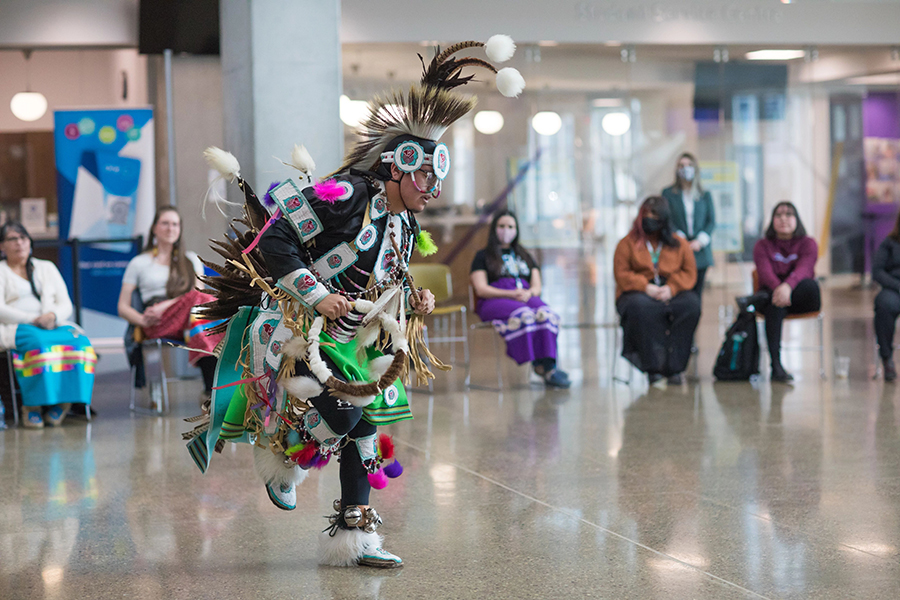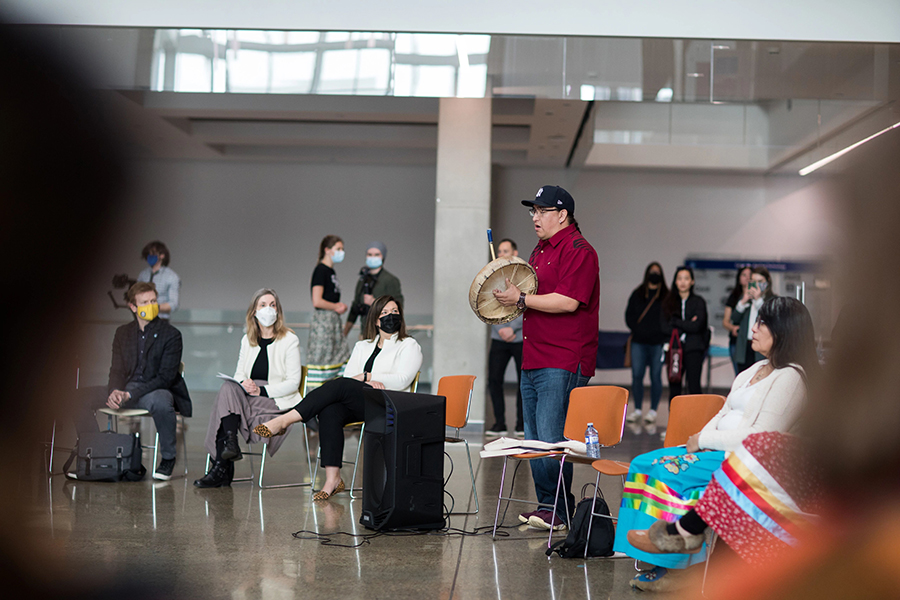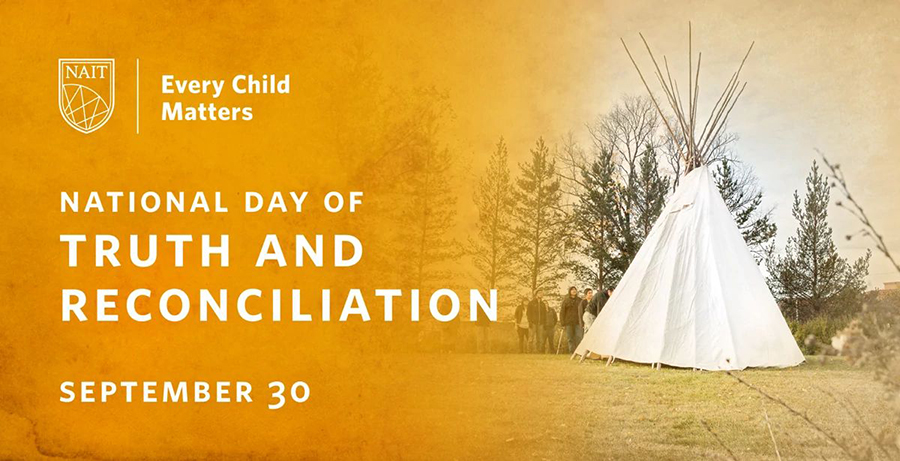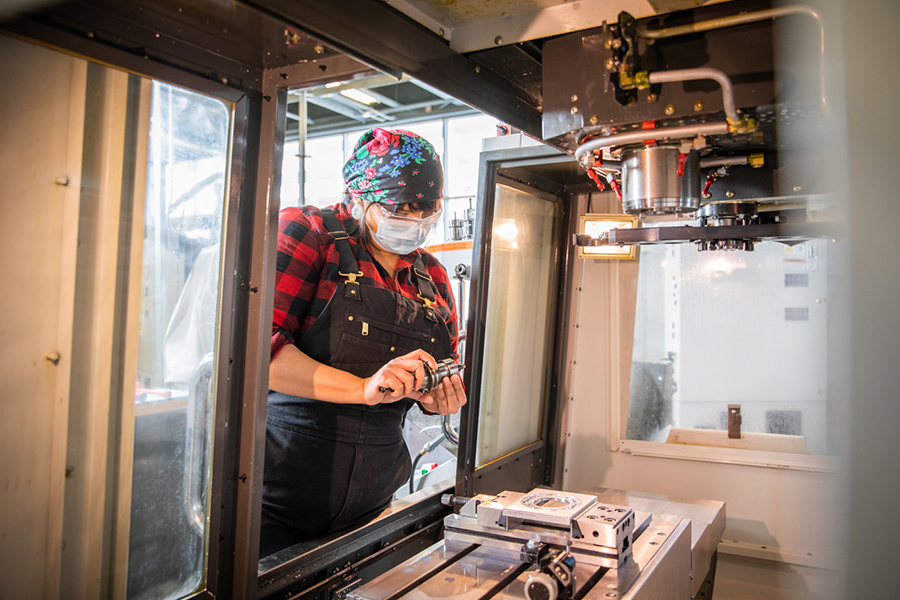The importance of education, reflection and being uncomfortable
Sept. 30 is not your conventional federal statutory holiday. Whereas other such days might offer the opportunity to escape to the cabin or campground, the National Day for Truth and Reconciliation is a day to engage with Canada in a different way.
It's an opportunity to reflect upon the impact, legacy and intergenerational effects of Residential Schools, which had the goal of assimilating First Nations, Inuit and Métis people into Canadian society. Sharing the date with Orange Shirt Day, the National Day for Truth and Reconciliation is also a chance to consider the story of Phyllis Webstad, whose life was forever altered by her childhood experiences at a school in 1973.
Inquiring from a settler perspective, we asked staff at the Nîsôhkamâtotân Centre at NAIT – manager Derek Thunder, Aboriginal liaison specialists Dawn Lameman (Bachelor of Business Administration – Management ’16, Accounting ’12) and Camille Louis, and support staffer Sharyn Cree – what we can do to acknowledge the day and honour the survivors of residential schools and the children who never came home.
Here, they share their thoughts on Canada’s path to reconciliation, advancements at NAIT and – with kindness but firmness – why it cannot be their job alone to tell everyone how to acknowledge the day.
Why it’s important that Canada marks this day

Derek Thunder: The fundamental piece is just having a day for people to reflect on our history [and] understand that there is no history without Indigenous people. We need to understand that truth before we can do any reconciliation. It needs to be acknowledged.
Sharyn Cree: Sept. 30 needs to be more of a day of actually participating and learning about what the day is about, rather than just being another day off.
Recognition as a step forward
Dawn Lameman: Canadians [as a nation] always question the existence of racism in Canada. They need to accept that there is racism and always has been. Canada is a colonial state. Recognizing this day is a way to get started with recognizing that, so that we can move forward to reconciliation.
When you make apologies, they’re meaningless unless there’s action beind them.
Thunder: Things like land acknowledgements and a day of recognition, all these pieces move toward reconciliation. But actions speak louder than words. Those are introductions to reconciliation but, when you make a promise to change things, when you make apologies, they’re meaningless unless there’s action behind them. There has to be action behind them.
Ways to recognize the National Day for Truth and Reconciliation (suggested following research guided by this conversation)
After picking up an orange shirt to show solidarity and help start conversations about truth and reconciliation (get one at shopATNAIT, where $10 from each shirt goes to the Orange Shirt Day Society) it’s easy to find ways to recognize the National Day for Truth and Reconciliation.
Check with your municipality for events. A variety of activities are planned for Edmonton and surrounding communities, from plant giveaways to gatherings and walks.
Books are a great way to gain insight into the impacts of colonialism and the lived experience of Indigenous peoples. Check out the Sharing Circle: Virtual Bookshelf, a collection of materials curated by the NAIT Library.
The National Film Board features a channel focused on Indigenous Voices and Reconciliation. You can stream videos, including dozens of documentaries, for free.
Consider participating in a blanket exercise. This educational activity illustrates the shared history of Indigenous and non-Indigenous peoples in an engaging and emotionally moving way.
Read the 94 Calls to Action made by the Truth and Reconciliation Commission to “redress the legacy of residential schools and advance the process of Canadian reconciliation.”
Reflection – and education – as action
Cree: You can’t reflect if you don’t know the history. Not everyone knows the histories. Even some Indigenous people. I’m still learning a lot.
Thunder: We talked at NAIT’s new student orientation in August and asked people the significance of Sept. 30 and why we don’t have classes that day. It was very rare that any of the participants understood why Sept. 30 was a holiday, that it was in reference to truth and reconciliation. A lot of people don’t know.
Cree: Even in high school, we barely learned anything about Indigenous histories, like residential schools. Maybe one day in social studies. It needs to be better.
A day of mourning
Camille Louis: Sept. 30 is also an opportunity for Indigenous people and communities to take time for themselves to grieve and mourn, and not put in so much work to educate people. That's always the cycle that happens: Whenever there's an Indigenous event or day [for building awareness], the work and burden falls on Indigenous people. Sept. 30 needs to be a day where you don't ask anything from an Indigenous person, because they’ve been through enough.
It also needs to be a reminder that it's also Orange Shirt Day, which preceded National Day for Truth and Reconciliation by several years. You can wear orange shirts in public or hang shirts outside your homes. And there will be events throughout the city. Participating is a way to show you’re trying.
Where we’re at as a country in our journey toward reconciliation
Lameman: It’s still the beginning. It's going to be ongoing learning for life, until everybody acknowledges and recognizes that colonialism still exists in Canada. It's not something in the past. It's still occurring.
Thunder: The fundamental piece for me is to be open minded. Indignenous people had to learn the Western way of doing things. Now, it's an opportunity for people to learn our way of doing things and understanding, our culture, language, all those pieces.
Lameman: We were forced to attend residential school. Everybody else gets to choose whether or not they want to learn about truth and reconciliation.
Thunder: That choice is an opportunity.
What comes after Sept. 30

Thunder: A day may have been set aside but don't just focus on that day. Always focus on working to see other ways of doing things and just being human – and embracing that humanity with regards to how we should work together.
Use Sept. 30 as a true day of reflection with regards to what you've learned. Then ask yourself, What more can I do in support throughout the year?
Louis: One of the most important things is for people to be willing to have conversations on both sides. Because that's where healing can happen and that's where learning can happen. And for people to be uncomfortable [during those conversations] is so important, because it's not a comfortable process. It was never intended to be.
I think that sometimes when people feel uncomfortable, they feel like they're being attacked, or blamed or shamed. But it’s not the same thing. And I think it's important for people to recognize where they're at and to be transparent about that. I welcome all of those questions and those conversations. It comes back to that humanity that Derek was talking about. If you're willing to have a talk with somebody, that's really productive and constructive.
Thunder: A little bit of uncomfortability – to me that's nothing. Aboriginal people lost their lives. Aboriginal children lost their lives. So what's a little bit of uncomfortability with regards to wanting to learn the history? It's all our history, not just Aboriginal history.
Reconciliation at the post-secondary level

Lameman: If people verse themselves with the Truth and Reconciliation Calls to Action, they will learn that there's something that they can do within their classrooms, within their schools to get the word out, because truth and reconciliation is everybody's responsibility, not just ours.
Louis: I think everyone owes it to support Indigenous students in Canada so that they can thrive in these institutions, which, we have to remind ourselves, were created for the subjugation of Aboriginal people. For example, at one point, if an Indigenous person pursued post-secondary education to become a lawyer, they would lose their treaty status.
When it comes from leadership and trickles down, you do see a difference all the way from presidents to the actual students. And we have seen a positive shift in the last few years. We have to keep the momentum going.
Thunder: Something simple is purchasing an orange shirt. When you're wearing an orange shirt, it starts a conversation. And what a wonderful way to have a conversation – at a post-secondary, a place of learning. And to have that conversation no matter how uncomfortable we are. It’s got to start somewhere.
How NAIT has responded to the Truth and Reconciliation Commission’s 94 calls to action

According to Reconciliation Education, the 94 Calls to Action are “actionable policy recommendations meant to aid the healing process in two ways: acknowledging the full, horrifying history of the residential schools system, and creating systems to prevent these abuses from ever happening again in the future.”
Following the release of the report, NAIT published its Aboriginal strategy, Connecting the Four Directions. Guided by the seven Grandfather teachings and ways of knowing and doing, the strategy is a resource for staff to work together to create meaningful change throughout their journey towards reconciliation.
Here are a few ways that NAIT and staff have responded to the calls to action:
- launched a new admissions pathway to address the systemic educational barriers for Indigenous students by providing a more culturally accessible way to apply for NAIT programs
- developed new processes around funding, including permitting tuition payment extensions for Indigenous learners to alleviate barriers to meeting payment deadlines from a third party, such as bands
- launched a sharing circle series called Pîkiskwetân (Let’s Talk), facilitated by the Nîsôhkamâtotân Centre, on Aboriginal perspectives and history
- created a new territorial land acknowledgement to demonstrate our shared understanding that NAIT is located on land that was, and continues to be, Treaty Six territory and that we recognize there is more to learn and more work to be done
- created new curriculum for the School of Health and Life Sciences. All students will take a course covering Indigenous health issues that includes the history and legacy of residential schools, the United Nations Declaration on the Rights of Indigenous Peoples, treaties and Indigenous rights, teachings and practices. This is skills-based training in intercultural competency, conflict resolution, human rights and anti-racism
- established the Four Directions Bursary in response to the call to action to create equitable opportunities for Aboriginal students to succeed in post-secondary
– NAIT Staff